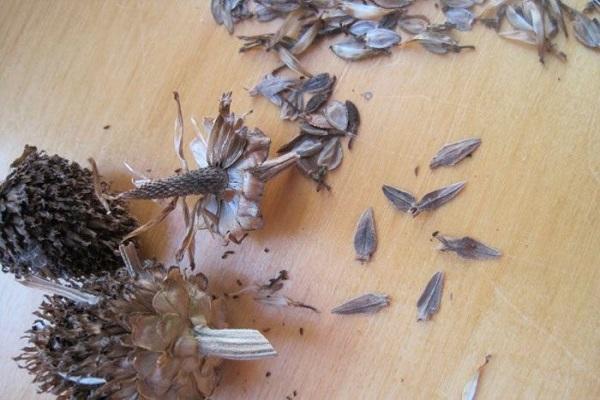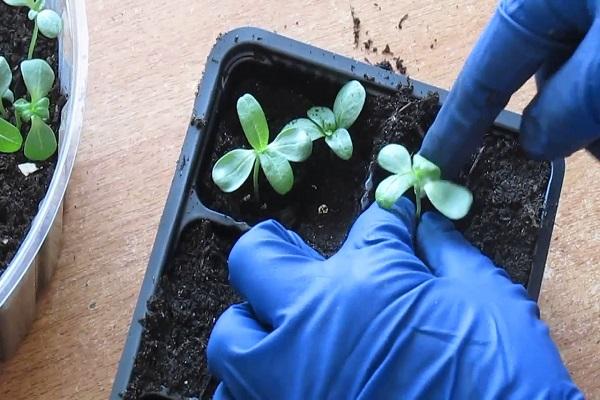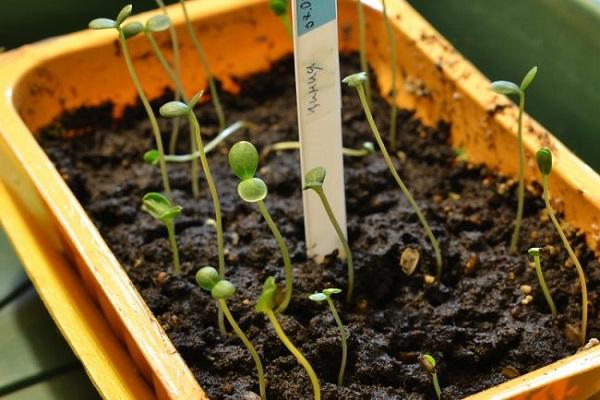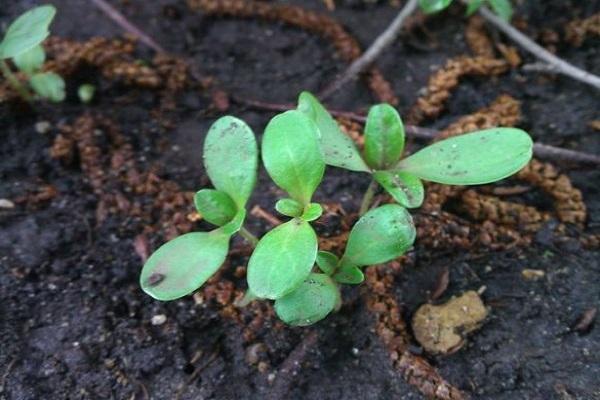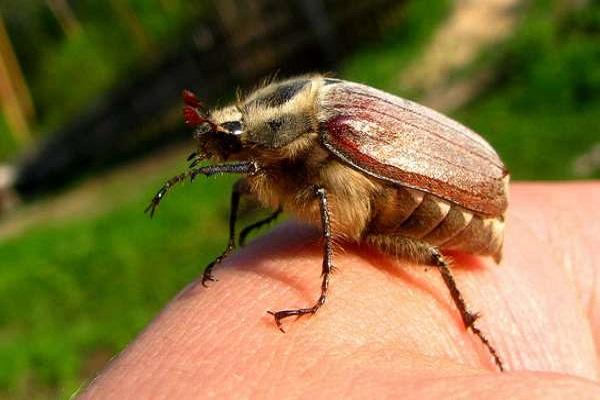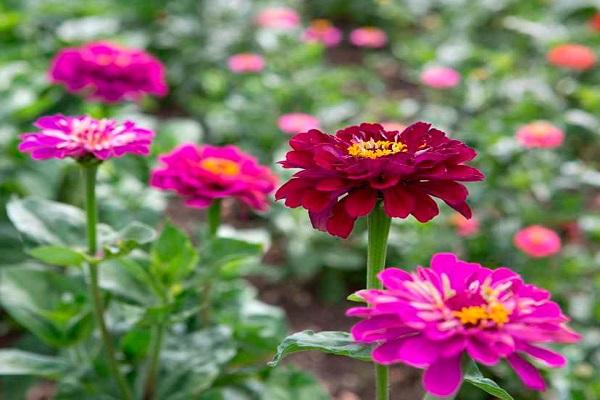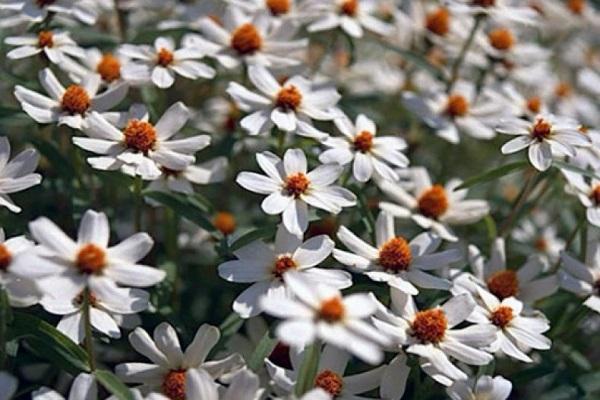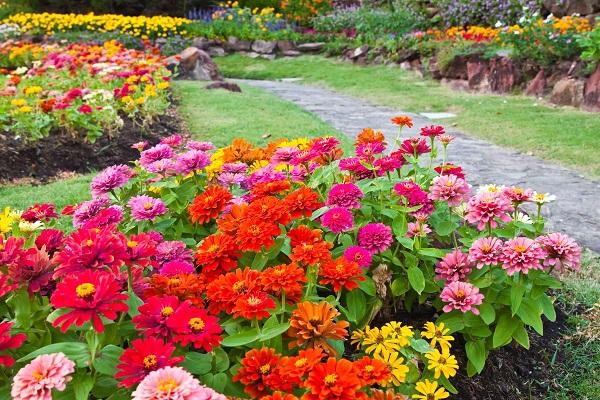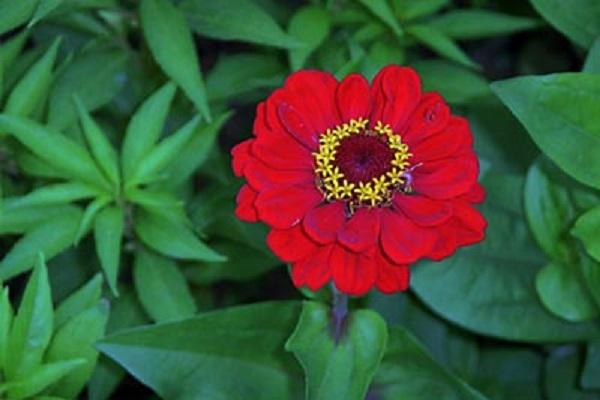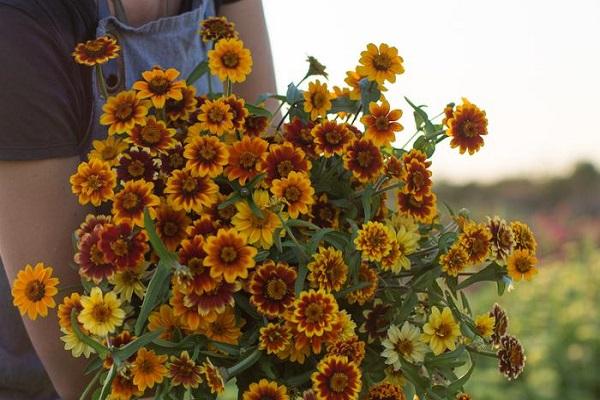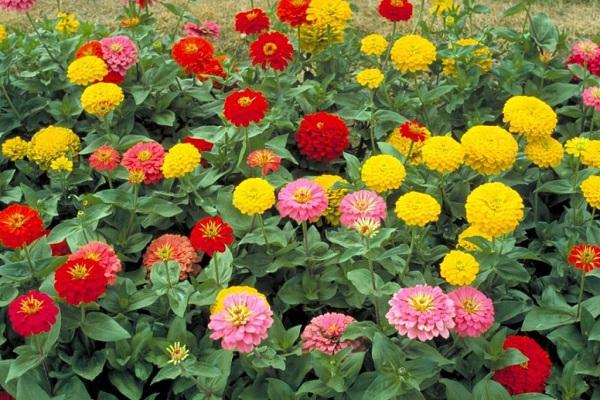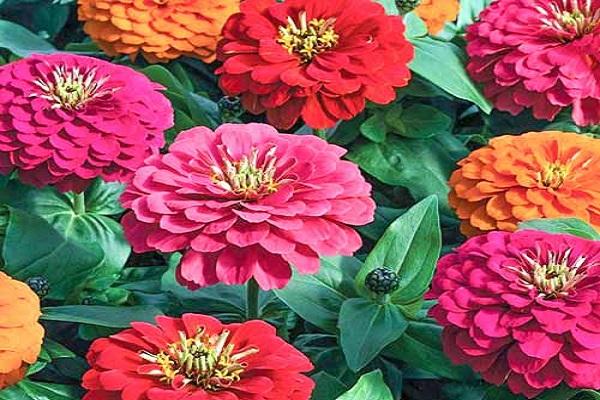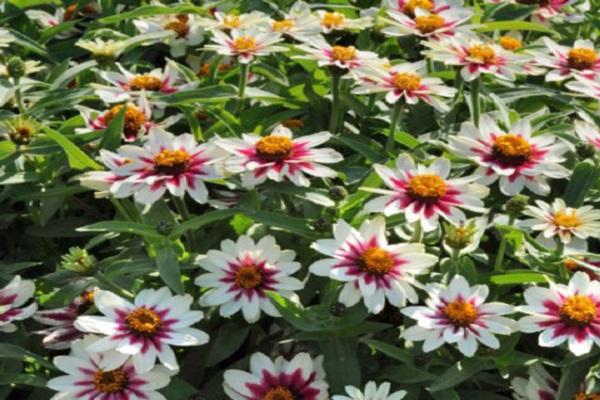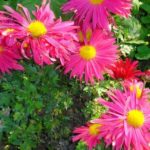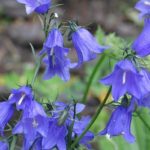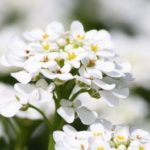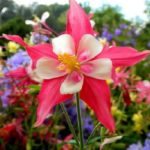Zinnia is a flower of the Asteraceae family. This is a perennial herbaceous and shrub plant, widely grown in the CIS countries. With its help, they decorate gardens, parks, alleys. Growing is not difficult even for inexperienced gardeners. You should first familiarize yourself with the planting and proper care of perennial zinnia.
- Description and features
- Growing from seeds
- Sowing
- Preparation of planting material
- Deadlines
- Seedling care
- What time to plant in the garden
- Preparing the land for planting in open soil
- Features of planting by seedling method
- Care of the majors
- Watering and loosening
- Feeding the majors
- Pinching zinnias
- Pests, diseases and their treatment
- Collecting seeds
- Wintering
- Kinds
- Narrow-leaved
- Graceful
- High
- Average
- short
- Fine-flowered
- Linearis
- Violet
- Orange koenig
- polar bear
- Little Red Riding Hood
- Tom Thumb
- Tambelina
- Fantasy
- Present
- California giant
- Scabiosa
- Glorienstein
- Persian Carpet Mixed
- Classic and Starbright
- Sombrero
- Golden Eye
- Caramel
- Yellow Star
- Cherry Ivory
- Scarlett Yellow
- Elegant
- Burpee
- Terry
- Fusion
- Zahara
- Decoration of flower beds
- Harvesting and storing zinnia seeds
Description and features
Zinnia comes from Southern Mexico, bred by the botanist G. Zinn. The Aztecs had been growing the perennial crop since 1500, but it began to be cultivated in Europe in the first half of the 18th century. Majors are not picky about growing conditions and grow in a wide variety of terrain. The bushes reach 0.2-1 meters in height. On the surface of the leaves there are hard hairs that serve as pubescence. The inflorescences are apical baskets reaching a diameter of 3-14 cm.
Colors include purple, yellow, white, blue, orange or red. The center of the flowers is brown-scarlet or yellow; the seeds are stored in the fruit. Pollen falls in the second half of June and ends with the arrival of the initial cold weather. Zinnia is resistant to dry periods and heat. Zinnia is widely grown at home and in the garden.
It takes root well in latitudes with moderate winters. In average climatic regions, flowers are bred according to the principle of annual plants. Popularly, the plants are called “majors”. Bushes tend to stretch upward, due to which the shadow disappears.
Growing from seeds
The soil in pots should be nutritious, loose, and drained. Gardeners recommend using a combination of garden soil taken from a flower bed with peat and river sand in a 1:1 ratio. The container should be low, but voluminous, then the planting of flowers will be common.You can sow seeds for seedlings in separate containers or peat tablets.
Sowing
Zinnia seeds are laid out 2-3 pieces in one hole. The planting should be 1 cm deep, no more, the distance should be 5 cm. The seeds spread on the soil are sprinkled with a little dry soil or peat, and the plantings are sprayed with a spray bottle. The containers are covered with cling film or transparent glass. The optimal temperature for germination of majors is 24 degrees Celsius. Then the first shoots appear in 2-3 days.
Preparation of planting material
The seeds should be rolled into a cotton pad and soaked in Epin solution. Last year's specimens will hatch in 5-7 days, older ones - after 7-10 days. The culture does not survive transplants well; it is not picked. Seedlings are hardened off in May by placing them on the balcony.
Deadlines
It is better to plant seeds for seedlings from the beginning of April. In the South, some gardeners plant majors in the fall, in October, but this is a risky step. Seedlings may freeze if the room temperature is less than 22 degrees Celsius.
Seedling care
Caring for the seed is simple; it is only important to moisten the soil with a spray bottle and ensure the optimal temperature in the room. Hardening off seedlings is an important step to ensure successful establishment in the garden.
What time to plant in the garden
Experienced gardeners recommend planting zinnia seedlings in the garden around June 6-10. The main thing is the absence of prerequisites for the return of cold weather. Sometimes planting work is carried out in the spring, at the end of May.
Preparing the land for planting in open soil
The area should be well lit and protected from drafts. The optimal soil is fertile, drained with a neutral alkaline reaction.The site is prepared in the fall by digging to a depth of 0.45 m. Weeds are removed, compost, leaf humus or rotted manure per 1 square meter of 8-10 kg is added to the soil. Among mineral supplements, superphosphate, potassium sulfate, and nitrophoska, 1 tbsp. each, are used. l, digging to a depth of 10 cm.
Features of planting by seedling method
Seedling material should be 1-1.5 months old. Zinnia should be planted keeping a distance of 0.3-0.5 meters between bushes. The flower is transferred with a lump of earth into the holes. The planted flowers will begin to bloom in early July.
Care of the majors
Zinnia is easy to care for; it is only important to water it on time, prune it, and treat it from harmful beetles and insects. It is also necessary to periodically loosen the soil and fertilize it to stimulate pollen. During budding, check the integrity of the inflorescences and stems. If they are dried out or damaged, remove them.
Watering and loosening
The bushes should be irrigated 2-3 times a month, paying attention to precipitation and soil. When the soil is dry, watering is necessary. Use settled water. Frequent irrigation should be avoided, otherwise the rhizome may begin to rot. After rain, faded inflorescences are excised so that pollen is more abundant and lasting.
The soil around the plant must be loosened regularly, removing weeds. Carry out the procedure carefully so that the stems are not injured. Usually weeding is done after watering. The event helps saturate the soil with oxygen, making it lighter. To reduce the amount of loosening, the soil around the zinnia is mulched with dry peat.
Feeding the majors
During the growing season, 3 feedings of zinnia nutrients are made. They should contain a low dose of nitrogen.The bushes are fed with liquid manure and mineral compounds at least 2 times during the summer. For the first time, the procedure is carried out a month after planting the seedlings, and the manipulation is repeated during the formation of buds.
Pinching zinnias
Proper pinching of zinnia is carried out in order to improve the splendor of the bush. This is done at the stage of growing seedlings and after establishment in the garden. Pinch them on 3 or 4 sheets. If manipulation is not done, flowers will grow on long peduncles, which are good for cutting.
Pests, diseases and their treatment
Zinnia is sometimes subject to attacks by harmful insects and diseases.
- Slugs, snails. It is better to collect them by hand. To make the process easier, lay out the pieces of roofing felt under which they fit.
- Maybugs. They are also collected by hand.
- Aphid. Fight insects with tar soap or Fufanon.
Among the diseases, the following variations occur.
- Spotting. The disease is serious and cannot be cured. The areas affected by it are removed, and in case of extensive infection, the plant must be burned.
- Gray rot. To cure zinnia, they resort to special drugs - fungcidia, for example - Fundazol.
- Powdery mildew. Pathology is one of the most common. It appears as whitish spots on the plant. Treated with fungicides, like Topaz.
With proper care, zinnia is rarely susceptible to these diseases and beetles.
Collecting seeds
Seeds appear 2 months after pollen begins. First, the first blossoming flowers are collected, their heads are torn off, and the seeds are taken out.
Wintering
When zinnia bushes are grown in a container or pot, they are moved indoors in the fall. Next, you will need the same care as for flowers in the garden.Only with proper wintering indoors will zinnia live for more than one season.
Kinds
There are about 20 varieties of zinnia, but only the following are cultivated in the CIS countries. They differ from each other in flower color and size.
Narrow-leaved
This is the easiest variety of zinnia to care for. The flowers are simple, narrow, yellow or bright orange. The bushes are spherical, small and up to 0.5 m high. A representative of the Asteraceae family is similar to marigolds.
Graceful
The stem is strong, the leaves are large, luxurious, semi-double. Their diameter is about 12 cm.
High
The variety is famous for its height of 0.6-0.9 meters, usually grown for cutting. In flower beds, the plant looks too massive.
Average
The stems reach 0.35 or 0.5 meters in height. The variety is grown mainly in flower beds.
short
Bush, dwarf zinnia reaches 0.15-0.3 meters in height, the stems are branching. The variety is grown in flower beds, pots or gardens.
Fine-flowered
A variety of zinnia native to Mexico, it is an annual plant with erect stems. It forms bushes 30-40 cm tall. The leaves are sessile, elongated, pointed, rich green in color. The flowers are small, 4 cm in diameter, monochromatic, bright orange. Pollen falls in June and lasts until the first frost. The variety bears fruit, the seeds remain viable for 2-4 years. Zinnia has been cultivated since 1862.
Linearis
Zinnia is distinguished by thin, sharp leaves. This variety is the smallest among its brothers. The bushes are branching, spherical, reaching 35 cm in height. The inflorescences are small, with yellowish reed flowers. The crop is widely grown in containers and pots; it looks harmonious on alpine hills and small flower beds.
Violet
The bush is spreading, 65-80 cm tall.During pollen, dense buds with a diameter of 11-13 cm are formed. The inflorescences are double, purple in color. The bush blooms from July until the arrival of the initial cold weather.
Orange koenig
Bushes grow up to 0.6-0.7 meters. The flowers are 14 cm in diameter, orange-red in color.
polar bear
The plant is compact in size, up to 65 cm tall. The buds are white, with a greenish tint.
Little Red Riding Hood
Zinnia grows up to 0.55 m tall, the inflorescences are dense, double, round. Their color is deep red.
Tom Thumb
The bushes are small in size, growing up to 0.45 meters. The inflorescences are dense, double, red. The shape of the flowers is a flattened ball.
Tambelina
The plant reaches 0.45 meters. Inflorescences of different colors, 40-60 mm in diameter.
Fantasy
The bushes are compact, spherical, up to 0.65 meters high. The leaves are large, rich green in color. The inflorescences are loose, curly, rolled into tubes. The color of the flowers is red, purple or yellow.
Present
The growth of the bushes is about 0.65 meters, the stems are bright green. The buds are similar to the Fantasia variety, but in bright red shades.
California giant
The plant grows up to 0.75-0.90 meters. The inflorescences are double, 11 cm in diameter. The flowers are rolled into tubes, the tips are wavy, of different shades: pinkish, red, yellow.
Scabiosa
Inflorescences with a diameter of 80 mm, tubular flowers, of various tones: pinkish, yellow, scarlet. The height of the bushes is 60-80 cm.
Glorienstein
The height of the bushes is about 0.25 meters. The flowers are double, dark orange, and brown-red at the ends.
Persian Carpet Mixed
Semi-double, two-color flowers of red tone with white, yellow, orange tints. The bushes look massive, like an oriental carpet.The buds have different shades: orange, yellow, dark red, with a yellow border.
Classic and Starbright
The bushes reach 0.4 meters in height. The stems are creeping, highly branched, thin and weak. Inflorescences are yellow, white or orange. The variety is grown as ground cover crops.
Sombrero
The variety is used to decorate flower beds. The flowers are brown-red, with an orange edge.
Golden Eye
The buds are tubular, white, like chamomile. Plant height is about 69 cm.
Caramel
The flowers are golden yellow, with a dark center. Bushes of low growth, up to 35 cm.
Yellow Star
The buds are deep yellow in color, the petals are small and multiple. The plant is low-growing, up to 35 cm tall.
Cherry Ivory
Low-growing bushes 20-25 cm tall, look great in flowerpots and gardens. The buds are lush, orange-scarlet with a cream edging, 8-10 mm in diameter.
Scarlett Yellow
Zinnia with double, large, two-tone flowers of a soft scarlet hue. The variety is widely planted in flower beds and flowerpots. The height of the bushes is 25-35 cm.
Elegant
The bushes grow up to 50-60 cm, with large, double inflorescences. The color of the buds is coral, soft pinkish.
Burpee
The inflorescences resemble chrysanthemums, double, with a diameter of 10 cm. The colors of the flowers are different: pinkish, scarlet, yellow, white. The bush grows up to 90 cm tall.
Terry
The bushes are strong, spreading, 50-80 cm. The flowers are large, 10-15 cm in diameter, double, orange-coral.
Fusion
A hybrid variety of low size, up to 45 cm. The diameter of the bushes is 50 cm, the leaves are lush, rich green. The color of the flowers is apricot or light orange.
Zahara
Low-growing zinnia bushes 35 cm tall, erect. The flowers are white, deep crimson in the middle, the petals are oblong.
Decoration of flower beds
Low-growing bushes can be planted on balconies, loggias, and flower beds. Tall varieties are ideal for decorating ridges; they are placed in vegetable gardens. You can combine several types of flowers to create a garden design of your own choosing.
Harvesting and storing zinnia seeds
Seed material is usually harvested in mid-summer. Place collected or purchased seeds in a paper bag for saving. They are able to sprout in 2-3 years. You can label each envelope with the name of the variety for convenience.

